| |
Response-guided Telaprevir Combination Treatment in Genotype 1 Chronic Hepatitis C Patients who had Prior Relapse to Peginterferon Alfa-2a/Ribavirin
|
| |
| |
Reported by Jules Levin
Presented at the American College of Gastroenterology Annual Scientific Meeting, Washington, DC, USA, October 28 - November 2, 2011
AJ Muir*1, B Adiwijaya2, F Poordad3, L Gritz2, L Bengtsson2, D Luo4, G Picchio4, RS Kauffman2, N Adda2.
1Duke Clinical Research Institute, Durham, NC, United States; 2Vertex Pharmaceuticals Incorporated, Cambridge, MA, United States; 3Cedars-Sinai Medical Center, Los Angeles, CA, United States; 4Tibotec, Titusville, NJ, United States.
We report here the rationale for the use of response-guided telaprevir combination treatment in patients with prior relapse to PR.

ABSTRACT
· Purpose: Results of the Phase 2 (PROVE3 and Study 107) and Phase 3 (ADVANCE, ILLUMINATE, and REALIZE) telaprevir (T) studies have indicated that patients who relapsed to a prior peginterferon/ribavirin (PR) therapy hadhigh on-treatment response and sustained virologic response (SVR) rates, comparable to the SVR rates in treatment-naïve patients.
· Methods: A post-hoc analysis of SVR and relapse rates was performed in patients with prior relapse according to treatment duration and undetectableHCV RNA at Weeks 4 and 12 (eRVR), and compared with treatment-naïve patients. Additionally, a viral dynamic model was developed to predict SVR rates by different PR treatment durations in both treatment-naïve and prior relapse patients.
· Results: Baseline characteristics and demographics in prior relapsers who hadeRVR were similar to treatment-naïve patients. In addition, early viral responses at Weeks 4 and 12 were similar between T12PR48 in prior relapsers and T12PR24 in treatment-naïve patients.
Relapse rates in treatment-naïve patients with eRVR were 6% (T12PR24) and 2% (T12PR48) in ILLUMINATE. In prior relapsers, the overall relapse rate was 3% in REALIZE. In prior relapsers with eRVR, the relapse rate was 7% (2/28) and 0% (0/24) in T12PR24 patients in PROVE3 and Study 107, respectively. The model predicted that the differences in SVR rates between T12PR regimens with and without response-guided PR durationin both treatment-naïve and in prior relapsers were similar (1-2%), consistent with observed clinical data.
· Conclusions: Among prior relapse patients who had eRVR and were treated with 24-week telaprevir combination treatment, SVR rates were comparable to or higher than those in treatment-naïve patients, and relapse rates were low. Modeling predictions and the observed clinical data support the use of response-guided therapy in prior relapse patients.

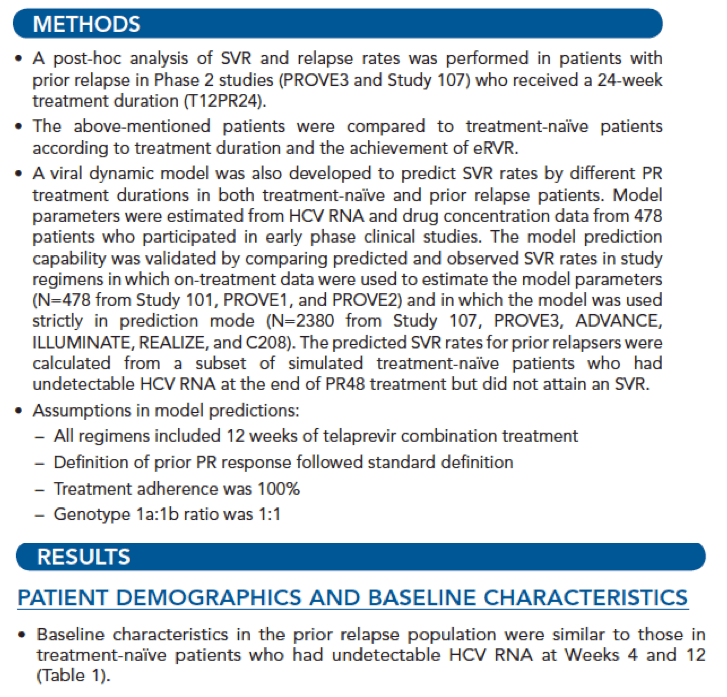
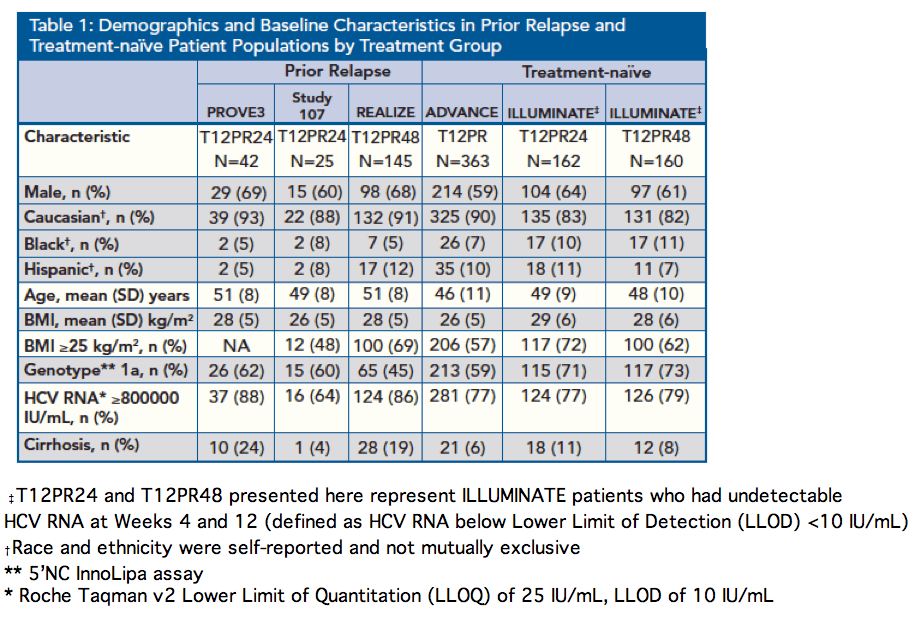
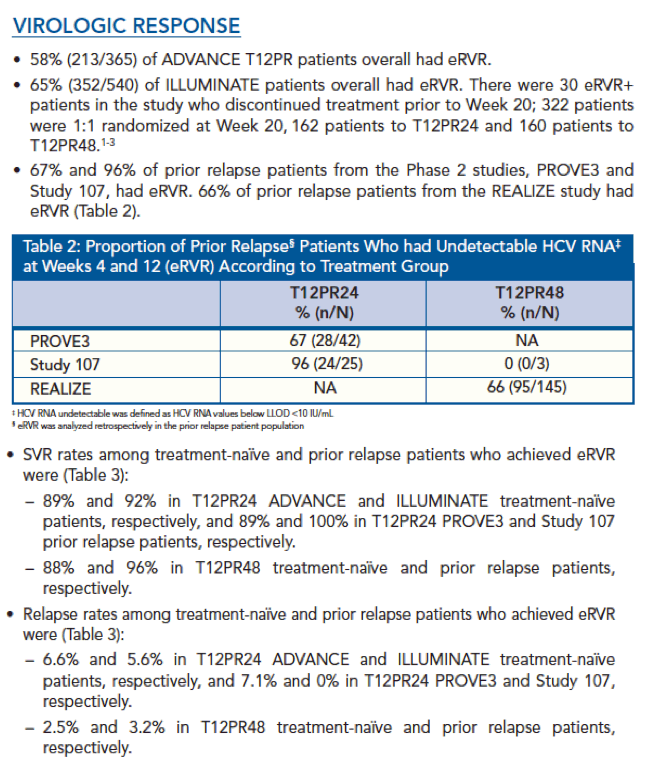
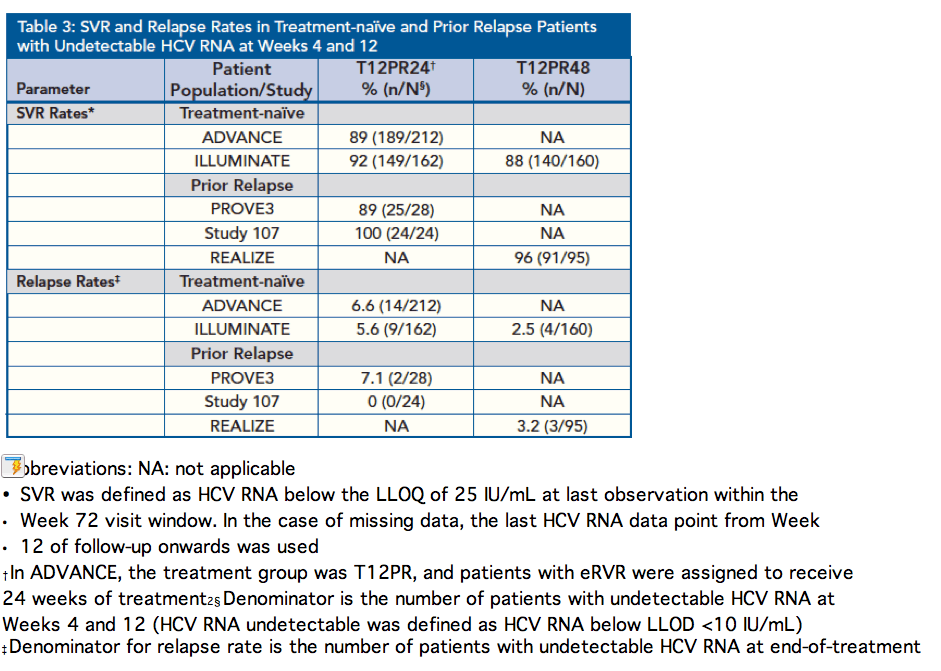
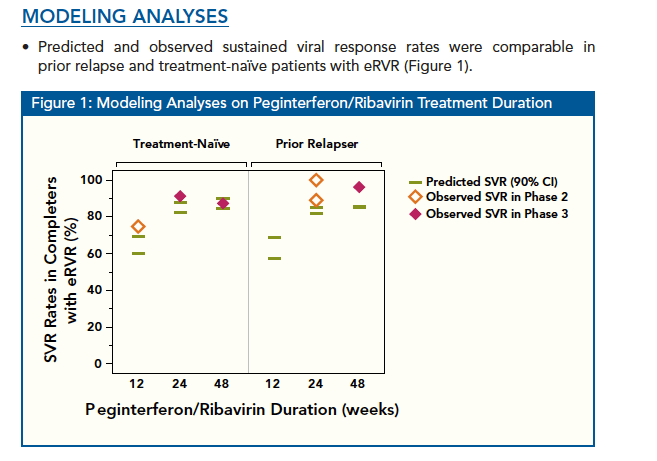
References
1. INCIVEK [package insert]. Cambridge, MA: Vertex Pharmaceuticals Incorporated; 2011.
2. Jacobson IM, McHutchison JG, Dusheiko G, et al. Telaprevir for previously untreated chronic hepatitis C virus infection. N Engl J Med. 2011; 364(25):2405-16.
3. Sherman KE, Flamm SL, Afdhal NH, et al. Response-guided telaprevir combination treatment for hepatitis C virus infection. N Engl J Med. 2011; 365(11):1014-24.
4. Zeuzem S, Andreone P, Pol S, et al. Telaprevir for retreatment of HCV infection. N Engl J Med. 2011; 364(25):2417-28.
5. McHutchison JG, Manns MP, Muir AJ, et al. Telaprevir for previously treated chronic HCV infection. N Engl J Med. 2010; 362(14):1292-1303. [erratum: N Engl J Med 362:1467]
6. Muir AJ, Poordad FF, McHutchison JG, et al. Retreatment with telaprevir combination therapy in hepatitis C patients with well-characterized prior treatment response. Hepatology. DOI: 10.1002/hep.24549.
|
|
| |
| |
|
|
|